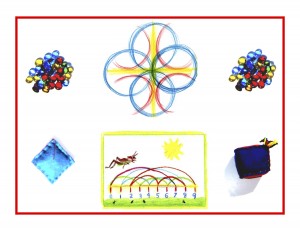Day 102
For one year, 365 days, this blog will address the Common Core Standards from the perspective of creating an alternate, ambient learning environment for math. Ambient is defined as “existing or present on all sides, an all-encompassing atmosphere.” And ambient music is defined as: “Quiet and relaxing with melodies that repeat many times.”
Why ambient? A math teaching style that’s whole and all encompassing, with themes that repeat many times through the years, is most likely to be effective and successful. As promised, today’s blog will be brief or actually, beyond brief. I’m reprinting Day 98’s post with a few minor adjustments, because it’s such a perfect fit! Today’s standard will be listed in blue, followed by its very ambient counterpart.
Operations and Algebraic Thinking 1.OA
Work with addition and subtraction equations.
8. Determine the unknown whole number in an addition or subtraction equations relating three whole numbers. For example, determine the whole number that makes the equation true in each of the equations 8 + __ = 11, 5 = __ – 3, 6 + 6 = __ .
The unknown number concept works well with the color strips. Using the examples above, place the two strips, green (addition) and blue (subtraction) next to each other.
For addition (green):
Place 8 gems or counters in the first square and 11 in the third.
The white square is second and must show 3 gems.
Place 6 gems or counters in the first square and 6 in the second.
The white square is third and must show 12 gems.
For subtraction (blue):
Place 5 gems in the first square and 3 gems in the third.
The white square is second and must show 8 gems.
Move the white square around to different positions for finding the unknown number (see the Day 98 post for details).
Continue with many similar equations, all under 20, using the gems or counters. Transition to working with the real numbers before writing the equations.
Using the color strips, expand this practice to include multiplication (yellow) and division (red) placed side by side. (Again, see the Day 98 post for details.)
Work with equivalent and inverse equations by comparing addition with multiplication and subtraction with division. Using the colored strips to see all 4 processes together in various relationships is an example of working from the whole to the parts. This is most beneficial, as is using the colored strips and white squares in place of the operation signs at first. This helps to not only simplify the process but also to work with the pictorial or visual aspect, so much more effective than abstract symbols at this age.
Knowledge ensues in an environment dedicated to imaginative, creative knowing, where student and teacher alike surrender to the ensuing of that knowledge as a worthy goal. More on the Common Core Grade 1 Operations and Algebraic Thinking Standards along with their ambient counterparts tomorrow!












